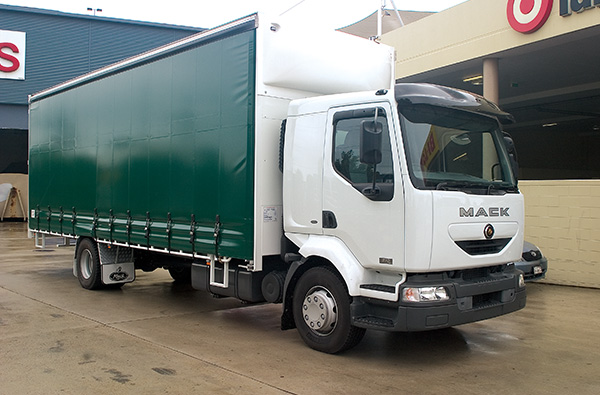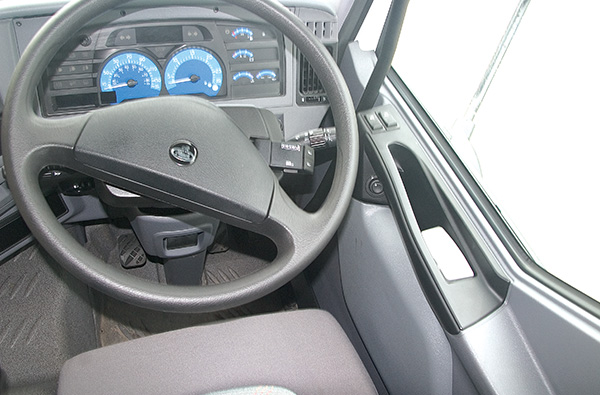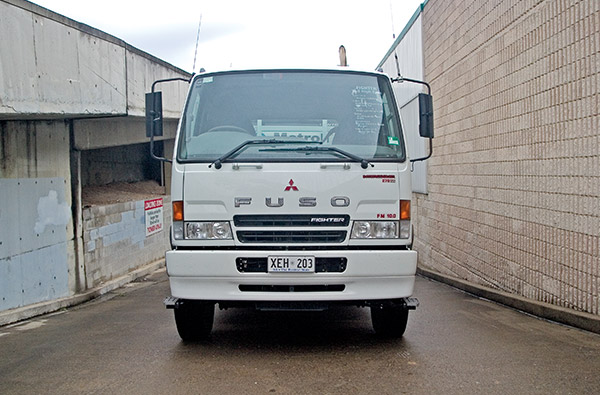Mack’s Midlum MV16 and the Fuso Fighter 10 come from either end of the truck spectrum into the same market segment. Tim Giles reports
When comparing the Mack Midlum MV16 to the Fuso Fighter 10 it is useful to remember their differences. One is a purely European product aimed and sold into a sophisticated home market with only limited export outside of Europe.
The other is from the Japanese market which takes a less sophisticated approach to truck design and which exports into many Asian markets.
The Midlum is a Renault designed and built truck from France and has been on sale there for some time. It will be the last Renault medium duty model because a joint Volvo/Renault range is expected to be released in Europe later this year.
Its cab is the same as the one on the DAF LF sold here in Australia, and was also used by Volvo for the VM medium duty truck launched in South America two years ago.
It is a quality cab, probably the best of its size in the Volvo group, and could be the basis for the cab of an integrated medium duty line-up when it arrives.
The Fighter is a long-time stalwart of the functional Fuso range and is expecting a facelift in the run-up to the engine emission changes in 2007.
For the purposes of this test the Midlum was fitted with a curtain-sider body and was fitted out as a typical distribution truck.
Although the Fighter used was a flat top it was loaded with a Fuso Canter demonstrator — this means that both trucks present a similar front profile and have similar aerodynamic performance.
The load on the Fighter did tend to throw the weight onto the front axle and wasn’t well-balanced. As a result there was a little bit of vibration from the front end and in the steering out on the road.
The Midlum is loaded closer to GVM at 14.79 tonnes while the Fighter is only running at just below 12t.
Fuel consumption is hard to compare on the two drives as the Fuso run took place on a day full of traffic disruption meaning a lot of time idling in stationary traffic on the streets of Brisbane.
Engine
Turning to the driveline; the two trucks come with similarly powered engines.
They both have turbochargers and intercoolers and use common rail fuel injection, but only the Fuso includes a catalytic converter.
Both engines produce similar horsepower, around 270 horsepower (200kW), so the difference in performance is the torque available.
The Fighter develops 785Nm where the Renault has 900Nm on tap.
This translates to much better acceleration from traffic lights for the Midlum and a driver can get up through the gears quickly on busy city streets.
Although both are common rail the Midlum’s Renault-built engine feels considerably smoother.
The Fighter essentially has a low speed diff matched with a lower torque engine so the whole package feels like a lower performance vehicle.
Transmission
Both trucks use Eaton nine-speed gearboxes and have range change.
The Midlum uses the knock-through range change technique while the Fighter uses a gearstick mounted switch.
There is no doubt that the Australian market much prefers the range change switch to the ‘slap-across’ type so popular in Europe.
In this respect the Fuso will come out as clearly better than the Mack in most customer’s eyes.
Cab and Controls
The trucks’ dashboards demonstrate the contrast between the two building philosophies.
The Fuso dash is very basic. It has an ashtray and cigarette lighter and a good radio with lots of functionality; while it does have a lot of buttons they at least seem to be properly marked with what they are supposed to do.
The instruments are minimal — two air tank pressure gauges, a speedometer with an LCD odometer, a tachometer, fuel and temperature gauges and that’s about it.
Jump into the Midlum and things are decidedly different.
The look of the blue-backed speedometer and tachometer is modern and stylish and includes a miles per hour indicator for those of us still living in the days of imperial measures.
It has a group of instruments similar to the Fuso’s but also has an LCD screen with a left/right toggle switch for scrolling through a series of menus including maintenance, diagnostics, self-test, luminosity adjustment and sound volume.
On top of this there are menus for language, time adjustment, warm-up selection and the setting of a default screen that, usefully, has an indicator of the gear selected, a fuel consumption reading and an odometer.
The dash of the Midlum features an LCD radio which displays station, volume, etc. This is coupled with one of those things that the French manufacturers did very early in the piece — steering wheel mounted radio controls.
The same stalk is available on the Qantum and Premium and has been for nearly 10 years, long before the feature appeared in their European opposition.
Counter-pointing all this technology the Fuso is simple and straightforward in everything it does. This particular model also has electric windows and central locking which are all controlled from the driver’s door armrest. In fact, four switches on the door of a Japanese truck must be some kind of record.
The dash of the Fuso has an air dump switch for the air suspension just to remind the driver that it isn’t only European trucks that have the luxury of an air-suspended rear axle.
From the driver’s seat it seems that the Mack probably has too much to offer.
For most operators buying a medium duty truck a diagnostics screen is a waste of time and the toggle switch that controls it doesn’t look like it would last long with constant use.
For many it probably constitutes some complicated electronics for nothing.
Drivers might just be better off forgetting about it.
So, this prompts the question, why fit it? The answer: it is a standard fitment for the European market and deleting it from the option list would not reduce the asking price.
The driver/computer interface for the screen is quite basic but is also counterintuitive.
When the new range comes out with electronic multiplexing Volvo/Renault/Mack will need to change the drivers’ electronics interface because this model is inadequate.
Performance
In the Fighter the gear stick linkage does have some looseness but it is not a major problem and gears are easy to find despite the floppiness.
The transmission in the Fighter will also have to do a lot more changing to keep up momentum in traffic because of the engine’s lower torque rating.
The Renault engine in the Mack is a nice little unit but for a European contender it’s probably a bit noisy. Nevertheless, it pulls really well.
It will lug well at less than 1000 rpm and pulled the 14-plus tonne load easily around the course.
Because it is such a responsive engine it could get away with a six-speed box and avoid the problem of a slap-across range change.
Another suggestion would be a range indicator on the dash — it’s easy to accidentally try to set off in high-range because there is no quick way to tell which range the gearbox is in.
Steering on the Midlum is smooth and effective although it still took three bites (same as the Fighter) to get it turned around.
The Fighter’s steering held up quite well despite being heavier over the front axle than the Midlum. There was never a point in the run that it did not respond exactly as it should.
If there was a competition for the most ineffective exhaust brake then the Midlum would be victorious — but only just.
Fuso use very square mirrors that look a bit basic but are effective and controllable. The main thing Fuso must consider is they have to match Isuzu and that means that the equipment they use can be basic but must be finished well.
Renault have long had a reputation for fitting comfortable drivers’ seats and this Midlum is no exception.
One interesting design feature of the Midlum is the mystery switch on its instrument panel. The switch is printed with the word ‘on’ but doesn’t seem to do anything.
Both trucks feature a fold-down middle seat with document and drinks storage behind. Unfortunately, the drinks holders on the Fuso are not quite big enough to handle the 600 millilitre Coke bottle used on ATN tests.
The Fighter has some nice little features like the well-shaped grab handle on the driver’s side A-pillar.
It droops down from its fitting so that it is useful when getting in and out of the truck.
The passenger’s side has the less-effective standard D-shaped handle.
Verdict
Both of these trucks have the features essential in a distribution truck — good visibility and a relatively low cab for easy entry and exit.
In comparing the fuel use it was surprising that the Fuso still used considerably less than the Midlum despite the traffic congestion. This probably indicates that there is a fuel economy penalty for the Midlum’s better performance.
So, if a truck buyer is looking for a truck that’s going to do big mileage it would be a good idea to go for something like the Mack Midlum. It’s more comfortable, more quiet and easier to drive.
However, if the truck is just going to be shuttling around town there’s nothing wrong with the Fighter. It’s practical and geared in a way to suit the low speed and stop/start nature of the task.
Mack Likes:
- Torquey engine
- Well-designed cab
- Comfortable seating
Dislikes:
- Knock-through range change
Fuso Likes:
- Fuel efficiency
- Simple range change switch
- Easy-to-use radio
Dislikes:
- Basic cab interior







